I’m right on progress, having done a bunch of embroidery and getting close to done on the petticoat (ie underskirt) and train (ie overskirt). Today I’ll talk skirts, tomorrow embroidery!
I put together the petticoat pretty much the same as I did for the under-petticoat. Except I have to confess: remember this long post I did, reengineering the pleats at the ends of the paniers? Yeah. I found that the BEST and easiest way to make things line up nicely is just to do the pleating OFF of the dress form/panier. Then you don’t have to do anything complicated, you can just pleat things up nicely and sew across the top edge. Duh.
I don’t seem to have taken a photo of just the petticoat, but here you can see it finished, along with some fabric draped in an approximation of what I was thinking the overskirt would be doing in front:
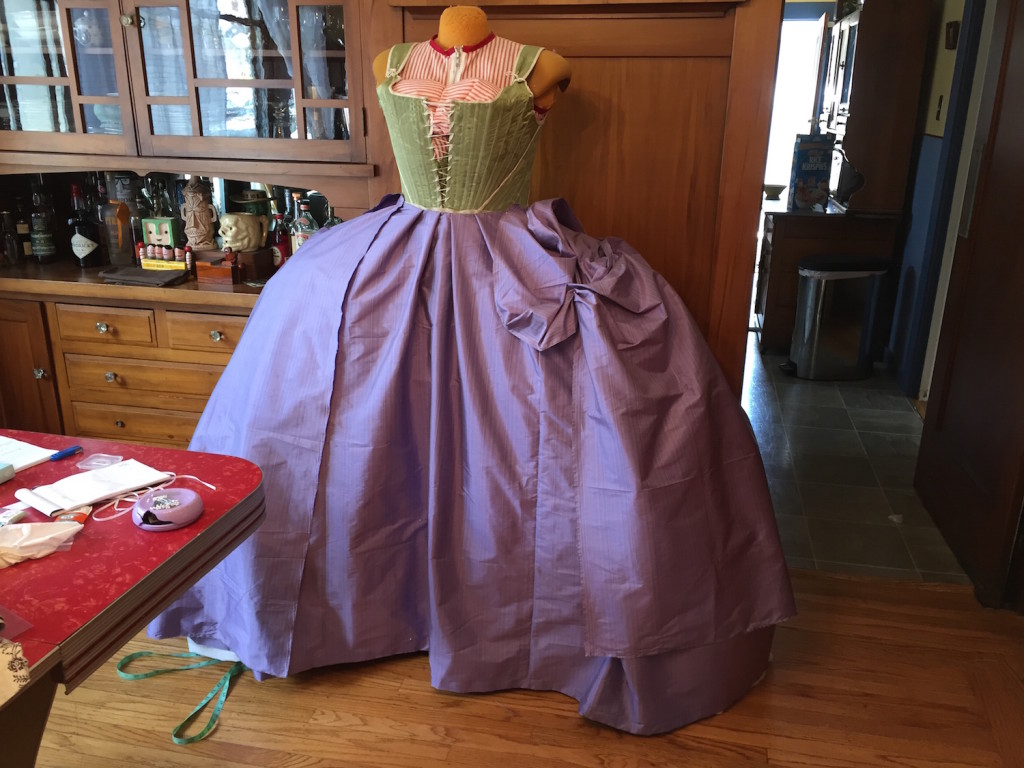
Now, one problem I have with my overskirt is that for most of the 18th century, the overskirt (called the “train” or “bas de robe” — literally “lower part of the dress”) looked like this:

Sometimes the train was pulled back even more dramatically, so that it barely shows at the waist in front, doesn’t even cover the corners of the panier, and simply all lays to the back, like this drawing:
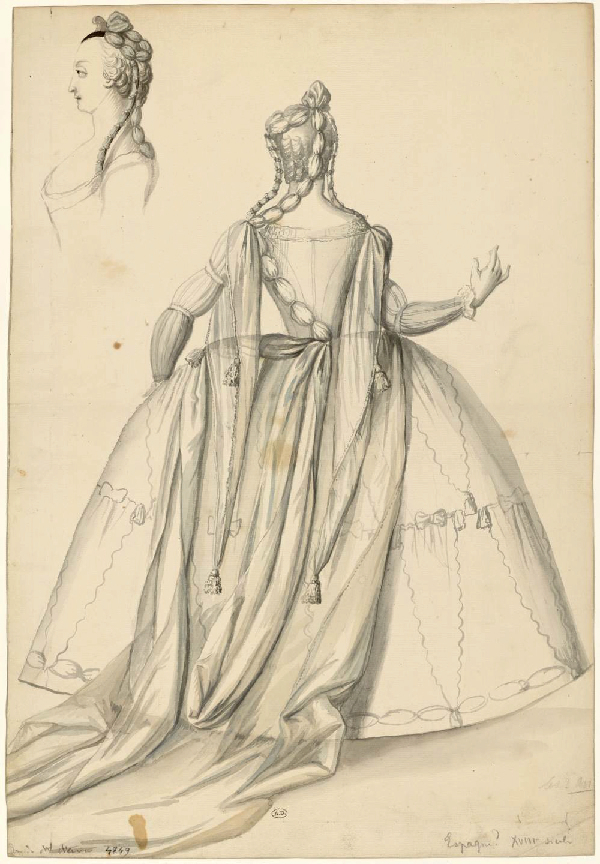
The issue is that these kind of trains are (relatively) well documented. Here’s a diagram from Diderot’s Encyclopedie that shows how these are cut. Essentially, there are three panels of fabric that are sewn together, then cut in half diagonally. Flip one side around, so the wide measures are both at one end, sew them together down the center, and pleat them up at the waist:
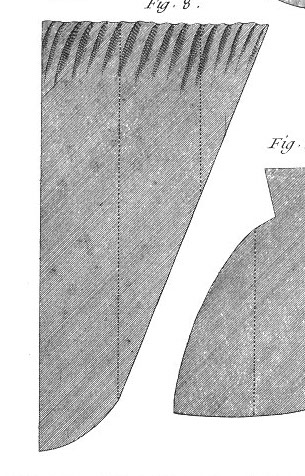
Here’s how the Encyclopedie Methodique (the 1780s equivalent of Diderot’s Encyclopedie) describes these trains:
The train of the court dress is two aunes [one aune is 47.25″] and a half long, and has six widths of 7/6 [of an aune] wide fabric all around. All widths of fabric are sewn together and the whole skirt is pleated in two lengthwise and cut in the bias, as seen from 1 to 3 [top right to bottom left]; the top is completely pleated from 1 to 2 [top right to top left]. These pleats are pulled together into a semi-circular shape ; each half of the skirt is bound and furnished with 4 or 5 hooks at regular intervals to attach it to the cord that was sewn at the bottom of the stays to this purpose.
The problem is that the dress that I’m making is from the 1780s, when things get (comparatively) weird. It looks like on many of these dresses, the train has merged with the more fashionable overskirt shape seen on a dress like the robe à la française. So what would this look like in back? Would it be cut the same way as described by the Encyclopedie? The only image I’ve found that shows the back of these kind of dresses is this, which I think confirms my suspicions about a merged overskirt/train combo:

So, I had to wing things. I basically used rectangles, cutting the fronts of the overskirt/train like I would on a française, with the back pieces longer to accommodate the train. Basically I used 4 widths (of 55″ wide) fabric. The two center pieces are longer for the train; because the skirt is open at the front, it’s basically a shorter piece from the side front opening, over the panier, to the side back, where the longer pieces start.
I did some math and using the Encyclopedie measurements, the train would be 118 inches long. That’s a serious train, like:
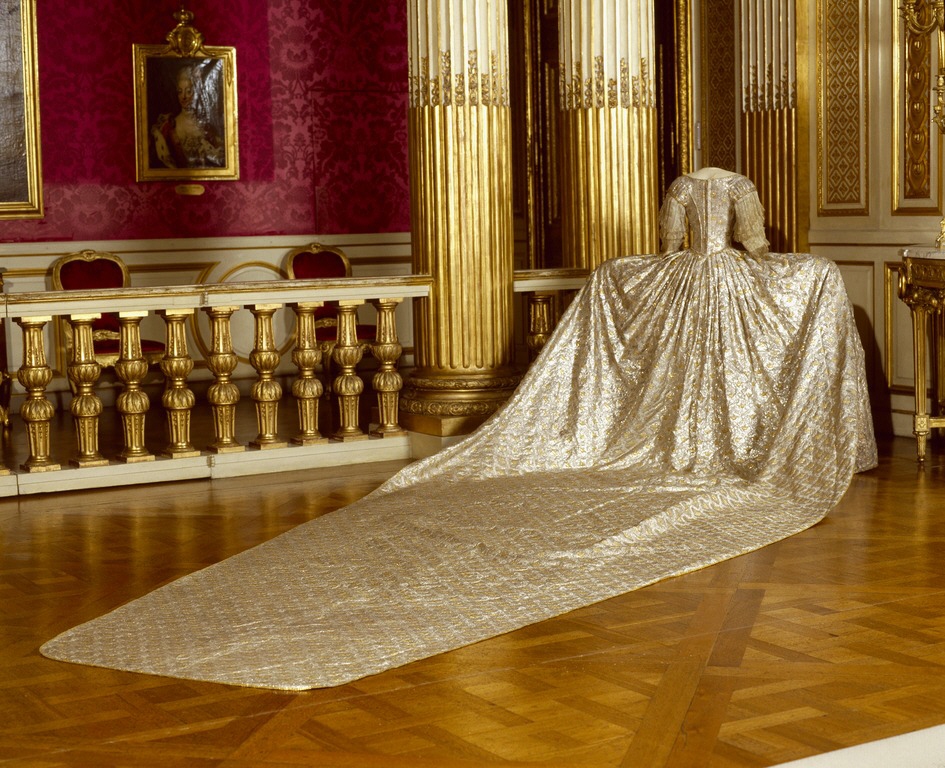
And while I really want this dress to be historically accurate, these people have clearly never been to Costume College (or anywhere with modern people, who have No Idea that such a thing as a train exists and essentially live to step on them). Yeah. Nope. I ended up draping some fabric around and went with a 30″ train (ie 30″ past where I’d regularly hem the skirt in back).


Now, in terms of the front, the drawing I’m working from has one side of the skirt pulled up:
I had originally planned to make the train/overskirt with one longer side, so that I could pull up the right side but still have it long enough to hit the ground. Well, I tried messing with that and ran into a problem:
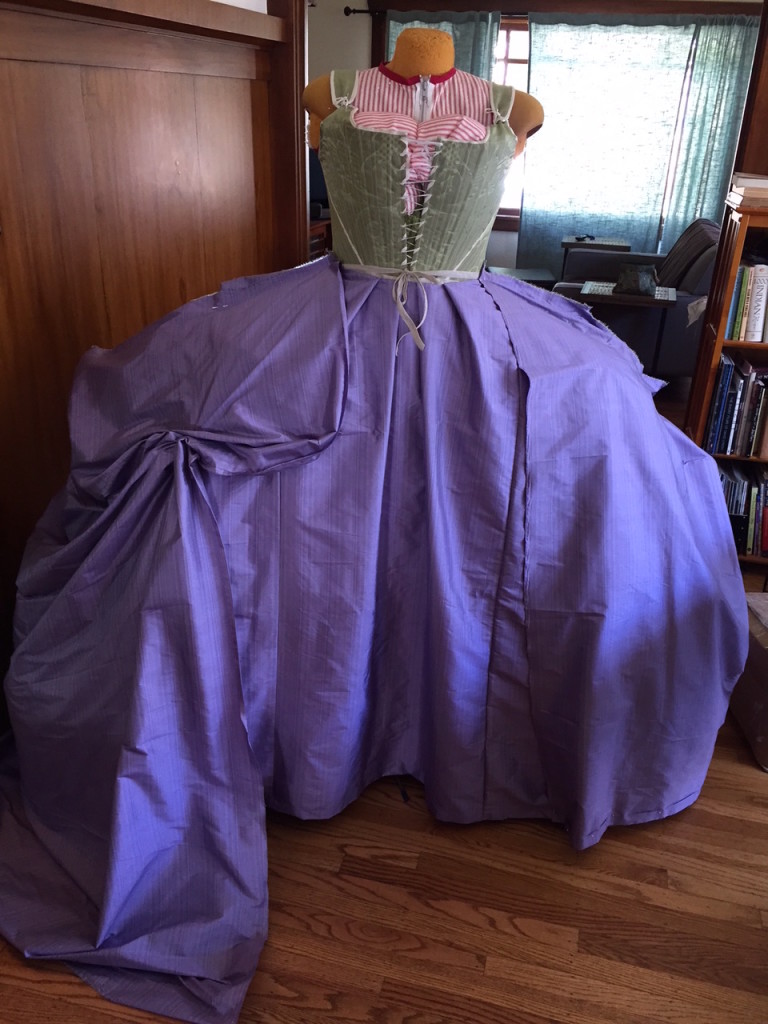
I would assume that the lack-of-bunching in the drawing was artistic license and just pleat it nicely and decoratively, except that how am I going to attach the embroidered band to all of this bunched up fabric? So I abandoned that plan, and made both fronts the same length, and will be cutting the swoop out of the right side.
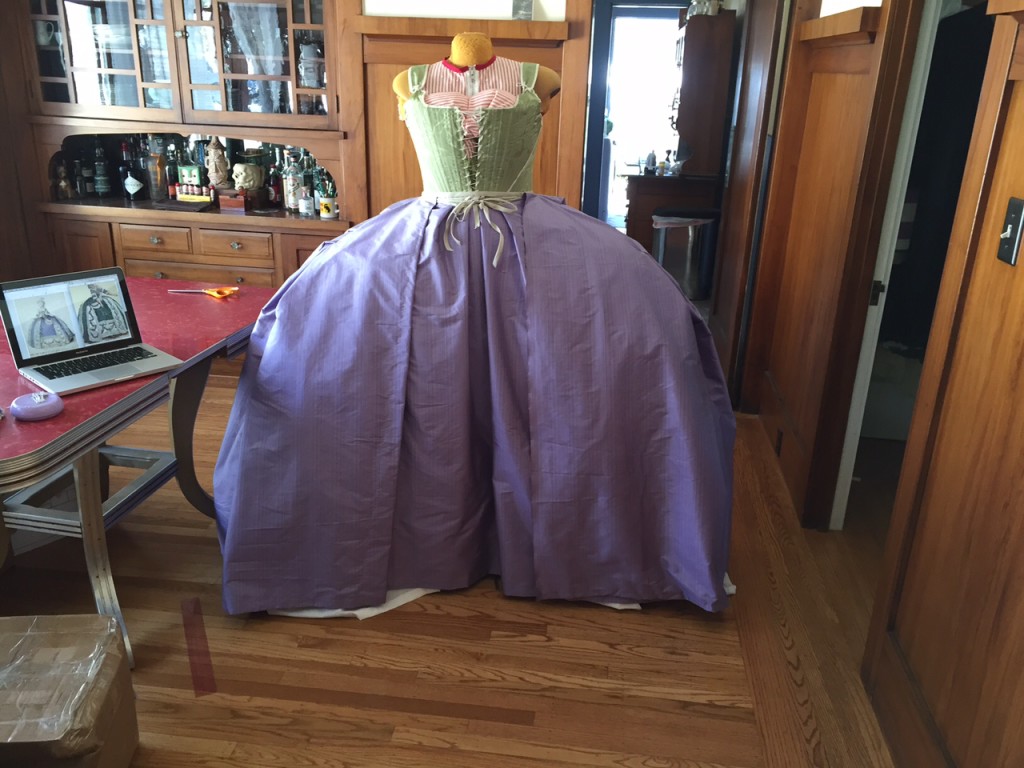
One thing I’m really interested in (given that I’m going to be wearing this to Costume College gala, and see above about trains and feet and ripping and heartbreak!) is this whole process of draping up the train. The Encyclopedie Methodique says:
Two buttons are sewn slightly apart form each other on the second width of fabric on each side of the skirt and a cord is sewn under each button on the inside ; the end of the cord is adorned with a tassel, and when the cord is tied up to the button it loops up the portion of fabric it encloses.
And what I’m wondering is, what did this actually look like? I’ve been combing through images and not finding much (given that most portraits etc. tend to show people from the front). About the only contender I’ve found is this image, which is from a masquerade ball. These two ladies (cropped from a larger image) seem like they’re wearing court dresses, but since they’re costumes, who knows.

If you can think of any images showing women wearing court dresses from the rear, I’d love to see them! I’m particularly thinking of any images of women on stage (dancing), as court dresses were worn for theater a lot, or at balls, since those are times when you’d definitely want your train up!
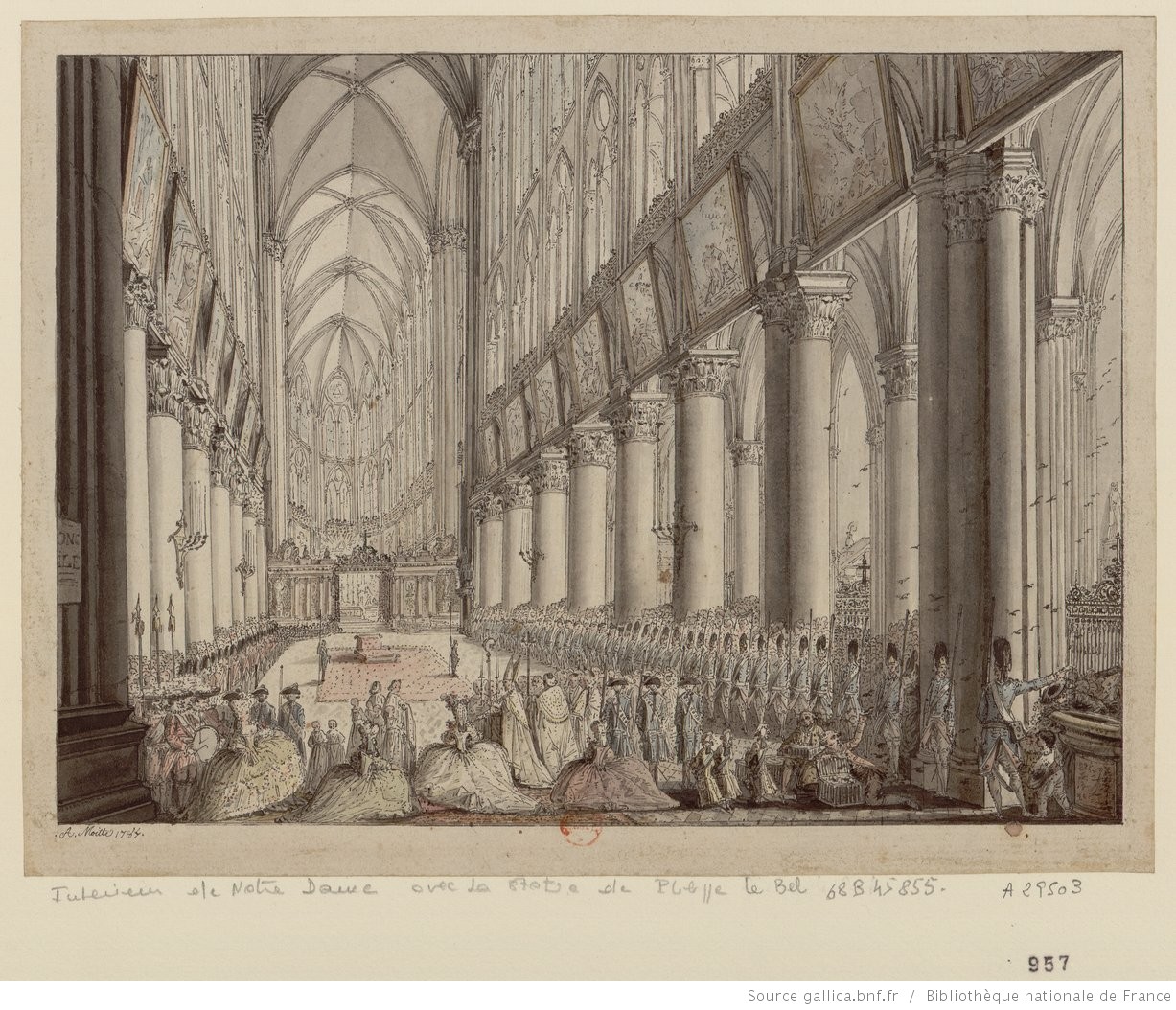
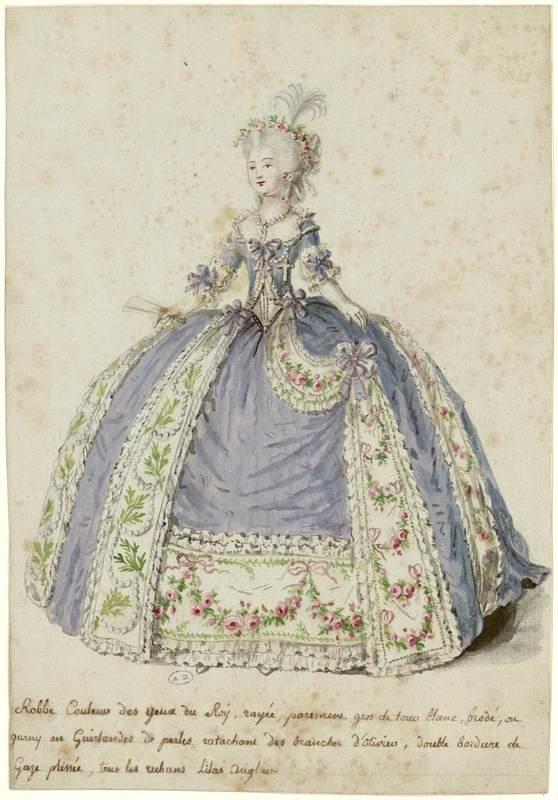
You just have to suffer! This is not a practical gown, hunty!
I’m totally prepared to suffer, just, I’d prefer the dress not get ripped on its first wearing!
A little late, but do you have the book called Dangerous Liaisons, which the Met published when they had bummed every scrap of furniture, room decor, and clothing from every museum and made poseable cloth dummies to simulate popular painting themes from the late 18th century? Mine is in storage, but there are a good number of period prints in there that may have what you need:
http://www.amazon.com/Dangerous-Liaisons-Furniture-Eighteenth-Metropolitan/dp/0300107145/ref=sr_1_1?ie=UTF8&qid=1434681845&sr=8-1&keywords=dangerous+liaisons+metropolitan+museum+of+art&pebp=1434681849602&perid=1SKVYZNA827D1M6DBW5Q